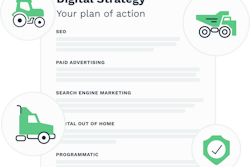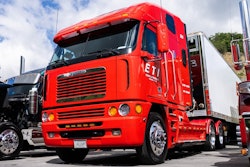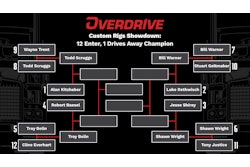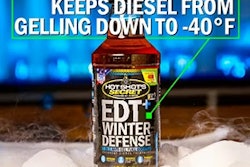
You're pulling a huge, mobile advertising opportunity every day -- an ideal place (particularly for dry van and reefer haulers) to put signage for your trucking company. Trouble is, you don't own that trailer, as is the case for many leased owner-operators and/or power-only haulers.
Bigger trucking companies can and do advertise their services with their trailers. But for many owner-operators, publicizing the business can be difficult -- unless you have a few trucking business branding tricks up your sleeve. Effective branding will help your business stand out from the competition, and stick in the minds of your clients, whether shippers, brokers, your leasing fleet and/or their customers, too.
What's so important about branding?
We get it -- you didn't get your CDL to spend your days fussing over logos and color schemes. But you're a business owner. Putting effort into your branding can only help your growth prospects.
Branding refers to the visual aspects and "personality" traits that define your company. Your trucking-company logo is a great start, but your brand can also be defined by the colors, photos and graphic elements you include on your website or business cards. The words you choose to talk about your company on social media? That’s branding, too.

Most importantly, your brand is what makes you different from other owner-operator businesses. It's the reason clients remember you and keep coming back, job after job.
Elements of your own personality might show up in your brand -- dependability, expertise, professionalism. But a unique brand also conveys a personality your clients won't find with others. Maybe it's your straight-talking, no-nonsense language. Maybe it's a tradition of excellence built on decades in the industry. Think about what makes your services truly different from other outfits and make sure it shows up in every email you send, every photo you post -- any public-facing document shared, really.
When you take the time to think hard about it and define your brand, and double-down on keeping it consistent, you'll keep more clients and see your company grow.
Owner-operator branding without a trailer
You can establish a recognizable brand -- even without control over your trailer’s appearance. Here's what we recommend:
Create your trucking company logo. If you create a professional graphic and use it right, it tells customers something positive about your brand. Eventually, clients will start to associate that positive quality with your company.
A good logo should look professional. Choose something that's:
- Unique and easy to recognize: It's great your competitor has a cool logo, but don't copy it, of course. Come up with a logo that sets your company apart and isn't too generic so that clients will remember and recognize it when they see it.
- Simple and clear: Detailed, intricate designs can be hard to see when they're small, and logos that are too specific can confuse your clients -- like a private joke they don't get. Choose an image or graphic that speaks to you. Odds are it will speak to others, too, if it's easy to understand at a glance.
Put the logo on your truck and use it to brand any and everything related to your company.
Branded uniforms. Add the logo to a shirt -- even better, a shirt and pants combo that looks sharp and pro. You don't have to settle for common khaki workwear. Use colors that complement your logo design. Some truckers have gone super-traditional with their own branding and donned logo'd shirt-and-tie combos, classic business dress. It's rare, but certainly unique for owner-operators in this day and age. Yet if your brand is youthful and a bit edgy, step outside the tried-and-true with casual branded hoodies.
Round out a uniform with matching pants, hats, beanies for the nonconformist in a cold climate. Consider branded accessories like gloves that can make a great give-away for your best clients.
[Related: Owners share slick salesmanship tricks, broker icebreakers, more]
Business cards. To some owner-operators, it might sound old-fashioned and stuffy to go through the trouble of printing business cards, yet they're more relevant than you might realize. They give your company credibility and make your business seem established. Plus, they're incredibly handy when you meet potential new clients or want to make sure that warehouse manager remembers you and walks away with your name and number.
Today's business cards often include a contemporary twist, like a QR code that automatically adds you as a contact in a client’s phone or takes them to your website (more on that in a moment). Or you can stick to the traditional format of listing your phone, email address, and website. Either way, include that company logo prominently. You'll be surprised how well a professional-looking business card is received by shipper and receiver staff you encounter at destinations.
Your company website. Even a one-man-band trucking outfit needs a website. It's a central place new or potential clients can go to learn more about you and your company and extend your brand. It's your chance to show them that you understand what they need from an owner-operator.
Websites don't have to be large and sprawling to showcase your experience, professionalism, and reliability -- a small, simply organized website with a few pages will likely cover your needs. It's the content that matters:
- Use the top banner to tell readers what you do and who you do it for.
- Include an “Intro” section where you address their pain points and tell them how you'll solve them.
- Add a "Services" page where you briefly describe each service you offer.
- Include an "About" page with an overview of your experience in the field.
- Put in a "Testimonials" section on each page where other companies you've hauled for say how fantastic it is to work with you.
- Always include a call to action at the bottom of any page, which tells a reader what step you'd like them to take next. On a small-business website, you can simply list your contact information or link to a Contact page to encourage readers to get in touch.
Conform the design of the site as much to your branding as you can -- use that company logo, and choose colors that go with it. Keep text fonts to a minimum -- say, one for the headings and one for the basic paragraphs and other text. When you're writing about the business, stick to on-brand words and ideas and show that, while you might be a small company, you're an expert at what you do and bring distinct quality to the way you do it.
[Related: The question every independent owner-operator business must answer]
Social media. Some owner-operators have been really good at cultivating an active social media presence, and it can be a fun way to show your company's personality and connect with potential customers. You don't have to spend too much time online -- just choose the two social media platforms your customers use most (Facebook, LinkedIn, X, etc.) and post content on those sites.
Ideally, use your logo and images that align with your branding -- many owner-ops use their truck, or an image of their logo branding on the truck's door, as a profile picture -- when setting up your social accounts. You can be less formal on social media, so don't be afraid to add pictures or videos of yourself at work. Follow potential customers and ask existing clients to leave reviews on your profile. Share industry news and stats that you find interesting -- posting relevant trucking content shows clients you're paying attention to the industry and you take your role seriously.
Custom email signatures. It's pretty simple to customize your email signature, and it can look far more professional than just typing your name or not having one at all. Think of it as the electronic equivalent of letterhead.
If you don't know how to update your email signature, do a quick Google search asking how for the email platform you use. You'll find plenty there. Include your logo and try to use the same text fonts you've used on your website and/or in your logo. Stick to the same color scheme, too, and include your email address, phone number, and a link to your website so clients never have to work too hard to get hold of you.
This should get you started. If it all sounds like too much to take on, hire a marketing and branding company, like the one I manage, that's specifically focused on trucking. An agency with experience working with trucking businesses will understand what you need from your branding and how to make it happen.
 Phillip Atwood
Phillip Atwood
Find more insight around customer outreach, building the business, and more in the "Independence and Growth" section of the Overdrive/ATBS coproduction of the Partners in Business playbook, a comprehensive manual for owner-operator careers. The 2025 PIB edition is newly accessible in this dynamic online content library format.
[Related: Keep an open mind -- eyes and ears, too -- for new customer opportunities]












